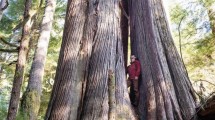Metasequoia glyptostroboides
previously known from fossil material was discovered as a living tree in the early 1940s in southeast China. The first seeds were received in 1948 in the Netherlands and the first plants were planted in 1957. The research on this species started in the beginning of the 1960s. The aim of the research was to investigate its possible use in forestry as a good alternative for other species. In 1967 an overview of the first experiences on Metasequoia glyptostroboides in the Netherlands was given. Research on the growth and habitus of the different clonals was done in 1992. In this study, the wood was examined regarding anatomical characteristics, physical-mechanical and chemical properties as well as durability. A total of 23 trees from two different stands was selected for this purpose. The data of the different properties were compared with those of Metasequoia glyptostroboides grown in other countries and other commercial softwood species. The average fibre length proved to be longer than the British data but shorter than the fibres measured on a specimen of Metasequoia from China. Strength properties and density gave lower values compared to data of Metasequoia from other countries and commercial species. The tangential swelling and shrinkage was relatively high. With respect to the chemical composition, the difference in the extractive substances of heartwood and sapwood was remarkable. The durability tests showed higher durability for Metasequoia heartwood than for Scots pine and Douglas fir. Presently, timber of the young plantation-grown Metasequoia is not of high commercial interest in the Netherlands. However, considering its production and good silvicultural treatment, the species might be of interest as a source of plantation grown softwood.
Metasequoia glyptostroboides
, die zunächst als fossiles Holz bekannt war, wurde 1940 in Südost-China als lebender Baum entdeckt. Die ersten Samen wurden 1948 in die Niederlande gebracht, erste Anpflanzungen erfolgten 1957. Die Untersuchung dieser Species begann um 1960 mit dem Ziel, sie also Alternative für die forstliche Nutzung zu verwenden. Eine Übersicht über die ersten Ergebnisse erschien 1967. Untersuchungen über Wachstum and Habitus wurden 1992 durchgefüht. In der vorliegenden Arbeit wurden anatomische und physikalisch-mechanische Eigenschaften und die Dauerhaftigkeit des Holzes untersucht. Insgesamt wurden 23 Bäume von zwei verschiedenen Standorten ausgewählt. Die Ergebnisse wurden mit Daten von Metasequoia aus anderen Ländern und mit Eigenschaften anderer Nadelhölzer verglichen. Die mittlere Faserlänge war größer als bei britischen, aber kürzer als bei chinesischen Bäumen. Festigkeitseigenschaften und Dichte lagen niedriger im Vergleich zu Messungen an Metasequoia aus anderen Ländern und an anderen Nadelhölzern. Tangentiale Quellen und Schwinden war relativ hoch. Bei den chemischen Komponenten ist der Unterschied im Extraktgehalt besonders auffällig. Die Dauerhaftigkeit war größer also die von Kiefer und Douglasie. Zur Zeit findet das Schnittholz aus der jungen Metasequoia-Plantage in den Niederlanden kaum kommerzielles Interesse. In Anbetracht des Wachstums sowie unter guter waldbaulicher Bedingung könnte dieses Holz künftig eine Rolle bei Nadelholzplantagen spielen.
Similar content being viewed by others
Author information
Authors and Affiliations
Rights and permissions
About this article
Cite this article
Polman, J., Michon, S., Militz, H. et al. The wood of Metasequoia glyptostroboides (Hu et Cheng) of Dutch origin. Holz als Roh- und Werkstoff 57, 215–221 (1999). https://doi.org/10.1007/s001070050044
Issue Date:
DOI: https://doi.org/10.1007/s001070050044




